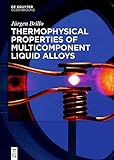Thermophysical Properties of Multicomponent Liquid Alloys / Jürgen Brillo.
By: Brillo, Jürgen [author.] .
.
Material type:  BookPublisher: München ; Wien : De Gruyter Oldenbourg, [2016]Copyright date: ©2016Description: 1 online resource (XI, 254 p.).Content type: text Media type: computer Carrier type: online resourceISBN: 9783110468991.Subject(s): Liquid alloys -- Thermal properties
BookPublisher: München ; Wien : De Gruyter Oldenbourg, [2016]Copyright date: ©2016Description: 1 online resource (XI, 254 p.).Content type: text Media type: computer Carrier type: online resourceISBN: 9783110468991.Subject(s): Liquid alloys -- Thermal propertiesFrontmatter -- Acknowledgement -- Contents -- 1. Introduction -- 2. Experimental methods -- 3. Density -- 4. Surface tension -- 5. Viscosity -- 6. Inter-property relations -- 7. Application examples -- 8. Conclusions -- A. Data -- B. Redlich-Kister parameters -- Bibliography -- Index
restricted access online access with authorization star
http://purl.org/coar/access_right/c_16ec
The book gives an understanding on how thermophysical properties change as function of alloy composition and complexity. In order to reach this goal, data on density, surface tension, and viscosity as functions of alloy composition and temperature are measured and discussed for pure liquid elements, liquid binary-, and ternary alloys.
This book reviews recent achievements in the field of thermophysical property measurements of liquid multicomponent alloys. The work is centered on the question of whether the dependence of these properties on material composition can be clarified in the liquid state, as the vast majority of technically interesting alloys are multicomponent. In order to obtain a detailed understanding of the macroscopic behavior of liquid materials, a precise knowledge of their thermophysical properties is a fundamental prerequisite. The role of containerless measurement methods, such as electromagnetic- or electrostatic levitation, are therefore, particularly emphasized. Through examples of density, surface tension and viscosity, mixing behavior is studied by moving stepwise from mono-atomic-, via binary- to ternary systems. It is hereby investigated whether common trends can be identified among similar systems and if the properties of a multicomponent alloy can be related to those of its subsystems. Established models are tested and validated. Inter-property relations, such as the Stokes-Einstein-relation, are reviewed and critically discussed. Finally, application examples are described. The book contains a useful data collection dedicated to the practitioner, the process engineer and devoted materials simulator. The present work contributes to a deeper understanding of the liquid phase and its thermophysical properties and to an improvement of Computer Aided Materials Design from the Melt. Also of interest titles: Benvenuto, Alloys and Metals, 2016 Davim (ed.), Metal Matrix Composites, 2014 Davim (Ed.), Machinability of Fibre-Reinforced Plastics, 2015
Mode of access: Internet via World Wide Web.
In English.
Description based on online resource; title from PDF title page (publisher's Web site, viewed 30. Aug 2021)


There are no comments for this item.